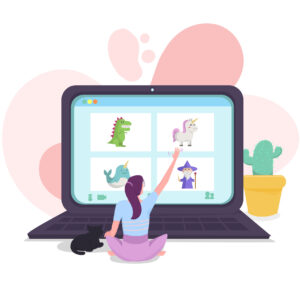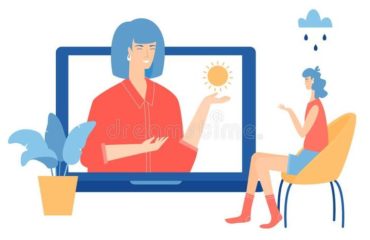
Have you seen your child mimicking their favourite dance moves from Chhota Bheem? Or maybe copying Doraemon’s actions? As impressionable young minds, children consider avatars and cartoons as their ‘equals’. Modelling after their peers, which can be virtual avatars, is a common trait found in all neurodiverse children.
The concept of avatars and video modelling can be traced back to 1970. The first reported use in therapy for autism spectrum disorder (ASD) was by Steinborn and Knapp in 1982. The goal was to teach the child methods to navigate the streets. A classroom-based model of a traffic environment was efficient in introducing pedestrian skills, which was later expanded to a behavioural training program.
Safe Spaces
Usage of evidence-based animated avatars aids skill acquisition and learning through visual means. Within the comfort of their home and a guardian beside, the child is free to explore unlimited possibilities in a semi-immersive VR platform. Our technology allows us to easily customize each experience according to the child’s goals, interests and likes. Children love cartoons, and we use this safe space to forge meaningful friendships between our avatars and learners, thereby making learning fun—an adventure.
“The detailed customization of avatars combined with the 3D and virtual-reality possibilities is truly immersive… induce incredibly deep emotional experiences among their users.”
Plugged In: How the Media Affects Youth
This can enable and empower children to be their true, genuine selves, instead of ‘masking’, i.e. mimicking neurotypical behaviours to camouflage in social settings.
Research-backed Learning Models
Buckley and Anderson’s general learning explains the effects of prosocial video activities and games. According to this model, many features of cartoons and animated avatars result in excellent learning situations.
- Virtual environments attract attention easily and thus are highly motivating.
- 3D avatars encourage active participation instead of passive watching. As a result, the overall experience is more welcoming and less threatening than face-to-face modelling.
- Digital mediums show all steps necessary to perform a specific behaviour, allowing focus on one aspect of a skill or behaviour at a time. Thus, they are heavily utilized in teletherapy.
- Lastly, they allow repetitive practice. The child can repeat the exercise and video as many times as needed to learn the skill.
The general learning model posits that prosocial media, in which the child and characters help one another, can increase both short and long-term prosocial behaviour. This can occur via a cognitive route, as established by Albert Bandura’s social learning theory (1977), in which the prosocial content primes identical prosocial approaches.
- It can occur via an emotional route, too, when players form strong emotional attachments to characters or avatars, which in turn improves their learning. [1]
- As with social cognitive theory and the capacity model, there is ample evidence to support the predictive value of the general learning model. [2]
Four Key Skills
Video modeling is highly effective in introducing new skills or improving existing skills to a higher level or with fewer supports. The end goal can be both the introduction of positive habits and replacing challenging or unwanted behaviours. Research has identified four key or ‘pivotal’ areas of development for neurodiverse children:
- Motivation: encourages learning by providing choices, varying tasks, combining previously learned tasks with new tasks, prompting, and using strategically placed incentives.
- Self-initiation: rewards children’s curiosity. This may appear in both subtle and overt forms. A child might inspect a new environment closely, or ask several questions about something they experience.
- Self-management: involves teaching children to be more independent and take responsibility for their learning.
- Responsiveness to multiple cues: teaches children to respond to various forms of the same prompt or instruction—for example, ‘Go to bed’, ‘Time to sleep’ and ‘It’s time to sleep!’
“Children’s activities in virtual worlds resemble their activities in offline ones.”
Developmental Implications of Children’s Virtual Worlds
These understandings and skills are translated to the real world. Unlike learnings from traditional therapy, which often fade away with time, a virtual companion brings forth a sense of responsibility. Such positive peer pressure enables the child to sustain concepts and generalize behaviours to actual, in-person scenarios.
Low Cost and Time
The estimated resources required to produce optimal results are minimal, compared to similar therapies and supports. Hence, this established technique is reliable and optimal for young learners aged 2 – 10. In India and beyond, most professionals including speech pathologists, occupational therapists and behavioural psychologists employ video modelling regularly.
Final Thoughts
Avatars empower the child and often boost their confidence by asking for help (instead of the other way around). When children teach their newfound skills to an equal, there is better retention. Further improvement is possible through healthy competitions introduced occasionally. Therefore, planning activities in real-time inculcates a much-needed sense of autonomy, helping them make their own decisions in the long run. Ultimately, our learners are empowered to build their own strategies and work towards long-term goals.
Fostering creativity and imaginative interactions is the key to our program. In an era when children can personalize avatars and experiment with identities in cyberspace, and when they can play games that allow them to construct homes, cities, and landscapes, the potential benefits are limitless.
[1] Katherine E. Buckley and Craig A. Anderson, “A Theoretical Model of the Effects and Consequences of Playing Video Games,” in Playing Video Games: Motives, Responses, and Consequences, ed. Peter Vorderer and Jennings Bryant (London: Routledge, 2006).
[2] Douglas A. Gentile et al., “The Effects of Prosocial Video Games on Prosocial Behaviors: International Evidence from Correlational, Longitudinal, and Experimental Studies,” Personality and Social Psychology Bulletin 35, no. 6 (2009).




You must be logged in to post a comment.